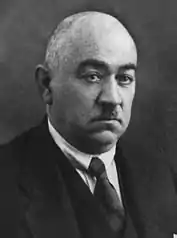Aziz Feyzi Pirinççizâde
Aziz Feyzi Pirinççizâde (born, 1878, Diyarbakır – 17 February 1933)[1] was a Kurdish politician and a member of the influent Pirinççizâde family from Diyarbakır.

Biography
As a member of the Ottoman Parliament for Diyarbakir, he was one of the main precursor of the persecution of the Armenians. After the peasantry population diminished due to the persecution of the Armenians in certain provinces of the Ottoman Empire, he advocated for the settlement of Kurdish tribesmen in the affected areas, in order to prevent German aspirations to have a say in these regions.[2] He also instigated against the Governor of Diyarbakir Hamid Bey, who was known to be rather tolerant towards the Armenian population.[3] Hamid Bey was replaced by Mehmed Reshid on the 25 March 1915[4] who were to become known as for his role in the extermination of the christian population.[5] Onwards he was an assistant to Mehmed Reshid, and a major force behind the chasing of the Armenian christian community. He organized the arson of the market of Diyarbakır in August 1914 together with other adherents to the Young Turks. One of them was the local commander of the police, Memduh Bey, who's release from custody he successfully demanded, after he was charged with it.[6] During the fire, a muslim mob destroyed many christian shops.[7] He was also a member of parliament where he reportedly held disputes with the Armenian deputy Vartkes Serengülian.[8] He and his cousin Bekir Sidki Pirinççizâde assumed a leading role in the massacres of the Armenian population of Diyarbakir. Both were involved in the Committee of Inquiry set up by Mehmed Reshid in order to find a solution to the Armenian question. Aziz Feyzi as a member of the Committee, and his cousin as a captain of the militia unit, which carried out the orders of the Committee.[9] In May 1915, Mehmed Reshid sent Aziz Feyzi to Mardin in order to organize the persecution of the Christians. In Mardin, Hilmi Bey has so far successfully prevented the persecution of the local christian community. [10] Following, he was deployed to Cizre, to continue with the persecution of the christian population.[11] After the surrender of the Ottoman Empire in 1918, he supported the Revolutionary Government based in Ankara.[12] He was arrested on 15 January 1919 and charged with involvement in the Armenian Genocide. The British deported him to Malta in May 1919, where he was in custody for two years in the citadel in Group A, which was reserved for the ones, who were directly involved in the massacres. In 1921, he managed to escape the island with 15 fellow inmates and returned to the Anatolian mainland to join the Kemalists .[13] During the Sheikh Said Rebellion, he initially was accused for supporting the rebellion, and had to appear before the Independence Tribunal, but was acquitted.[14] Following he was a facilitator of massacres and resettlements of the Kurdish population.[8][15] He was the Minister of Public Works during Revolutionary Government under Fevzi Çakmak,[16] again in the Government of Ali Fethi from November 1924 to March 1925.[17] In May 1927, he was awarded the Independence Medal by Abdulhalik Renda, at the time the speaker of the Grand National Assembly of Turkey.[8]
Family
Aziz Feyzi was the son of Arif Pirinççizâde, the father of the politician Feyzi Prinççioğlu[1] and the uncle of Ziya Gökalp.
References
- "Feyzi Pirinççioğlu". www.biyografya.com. Retrieved 2020-10-28.
- Üngör, Ugur Ümit (2009). "Young Turk social engineering : mass violence and the nation state in eastern Turkey, 1913- 1950" (PDF). University of Amsterdam. p. 218. Retrieved 27 July 2020.
- Kieser, Hans-Lukas. "From 'patriotism' to mass murder: Dr. Mehmed Reşid (1873–1919)" (PDF). University of Zurich. pp. 19–20. Retrieved 27 July 2020.
- Kieser, Hans-Lukas. "From 'patriotism' to mass murder: Dr. Mehmed Reşid (1873–1919)" (PDF). University of Zurich. p. 16. Retrieved 27 July 2020.
- Kieser, Hans-Lukas. "From 'patriotism' to mass murder: Dr. Mehmed Reşid (1873–1919)" (PDF). University of Zurich. pp. 2–3. Retrieved 27 July 2020.
- Kevorkian, Raymond (2011). The Armenian Genocide: A Complete History. I.B.Tauris. pp. 356–357. ISBN 978-1-84885-561-8.CS1 maint: date and year (link)
- Üngör, Ugur Ümit (2011). The Making of Modern Turkey: Nation and State in Eastern Anatolia, 1913-1950. OUP Oxford. p. 50. ISBN 978-0-19-960360-2.
- Üngör, Uğur Ümit; Polatel, Mehmet (2011-08-11). Confiscation and Destruction: The Young Turk Seizure of Armenian Property. A&C Black. pp. 156–157. ISBN 978-1-4411-3578-0.
- Üngör, Ugur Ümit (2011), p. 63–64
- Üngör, Ugur Ümit (2011), p.69
- Üngör, Ugur Ümit (2011), p.99
- Üngör, Uğur Ümit; Polatel, Mehmet (2011) p.138
- Üngör, Uğur Ümit; Polatel, Mehmet (2011) p.153
- Üngör, Ugur Ümit (2009). "Young Turk social engineering : mass violence and the nation state in eastern Turkey, 1913- 1950" (PDF). University of Amsterdam. p. 236. Retrieved 13 June 2020.
- Üngör, Uğur Ümit; (2009), p. 248
- Jongerden, Joost (2012). Social Relations in Ottoman Diyarbekir, 1870-1915. BRILL. p. 67. ISBN 978-90-04-22518-3.
- "Feyzi Pirinççizade". www.imprescriptible.fr. Retrieved 2020-07-27.